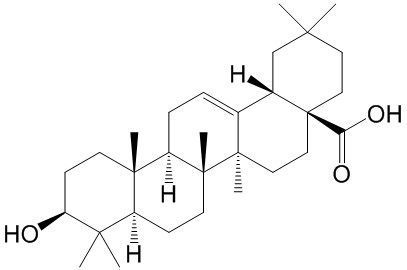Home
Products
Oleanolic acid



| Product Name | Oleanolic acid |
| Price: | $15 / 20mg |
| Catalog No.: | CN07922 |
| CAS No.: | 508-02-1 |
| Molecular Formula: | C30H48O3 |
| Molecular Weight: | 456.7 g/mol |
| Purity: | >=98% |
| Type of Compound: | Triterpenoids |
| Physical Desc.: | Powder |
| Source: | The herbs of Boehmeria nivea (Linn.) Gaudich. |
| Solvent: | Chloroform, Dichloromethane, Ethyl Acetate, DMSO, Acetone, etc. |
| SMILES: | O[C@H]1CC[C@]2(C(C1(C)C)CC[C@@]1([C@@H]2CC=C2[C@@]1(C)CC[C@@]1([C@@H]2CC(C)(C)CC1)C(=O)O)C)C |
| Contact us | |
|---|---|
| First Name: | |
| Last Name: | |
| E-mail: | |
| Question: | |
| Description | Oleanolic acid (Caryophyllin) is a natural compound from plants with anti-tumor activities. |
| Target | Human Endogenous Metabolite |
| In Vitro | Oleanolic acid (OA) suppresses the proliferation of lung cancer cells in both dose- and time-dependent manners, along with an increase in miR-122 abundance. CCNG1 and MEF2D, two putative miR-122 targets, are found to be downregulated by OA treatment [1]. OA induces autophagy in normal tissue-derived cells without cytotoxicity. OA-induced autophagy is shown to decrease the proliferation of KRAS-transformed normal cells and to impair their invasion and anchorage-independent growth[2]. |
| In Vivo | Mouse model experiments also demonstrat that OA suppresses the growth of KRAS-transformed breast epithelial cell MCF10A-derived tumor xenograft by inducing autophagy [2]. Activation of MAPK pathways, including p-38 MAPK, JNK and ERK, is triggered by OA in both a dose and time-dependent fashion in all the tested cancer cells. OA induces p38 MAPK activation promoted mitochondrial translocation of Bax and Bim, and inhibits Bcl-2 function by enhancing their phosphorylation. OA can induce reactive oxygen species (ROS)-dependent ASK1 activation, and this event is indispensable for p38 MAPK-dependent apoptosis in cancer cells[3].It is also proved that p38 MAPK knockdown A549 tumors are resistant to the growth-inhibitory effect of OA[3]. In OA-treated EAM mice the number of Treg cells and the production of IL-10 and IL-35 are markedly increased, while proinflammatory and profibrotic cytokines are significantly reduced[4]. |
| Density | 1.1±0.1 g/cm3 |
| Boiling Point | 553.5±50.0 °C at 760 mmHg |
| Flash Point | 302.6±26.6 °C |
| Exact Mass | 456.360352 |
| PSA | 57.53000 |
| LogP | 9.06 |
| Vapour Pressure | 0.0±3.4 mmHg at 25°C |
| Storage condition | 2-8°C |